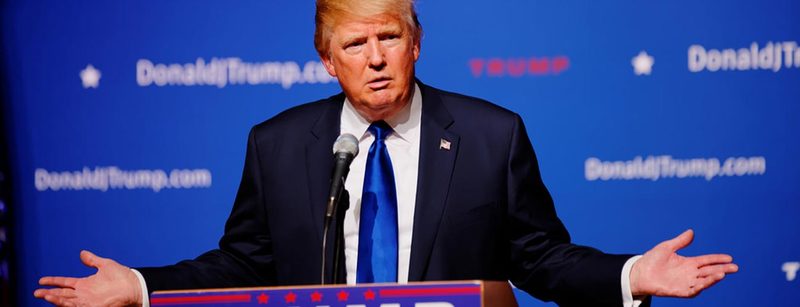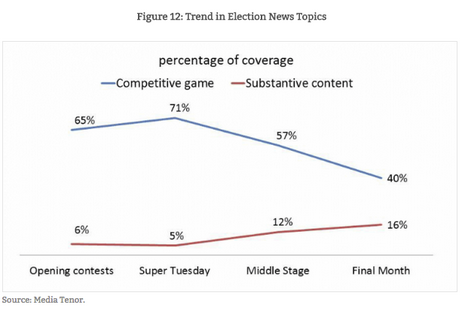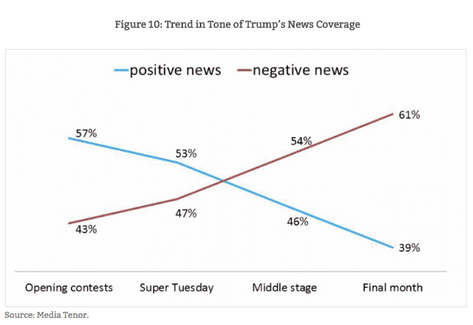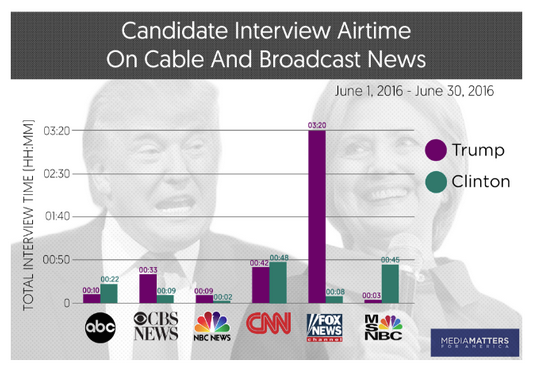Sign up for the daily CJR newsletter.
Donald Trump isn’t just a thoroughbred of horse race journalism. He’s Secretariat. The reality TV star built his campaign on wall-to-wall media coverage that Trump himself propelled with constant interviews, unscripted political rallies, and exclamation-filled tweeting. Not a day seemed to go by in the first half of the year without Trump using these platforms to boast of his latest poll numbers or electoral victories over a confounded Republican field—and let’s be honest, it was a viscerally irresistible storyline. Trump set the pace for the GOP primary horse race, even if he alienated countless onlookers.
A new report from Harvard’s Shorenstein Center suggests this media strategy was particularly effective at captivating mainstream news organizations during the early stages of the primary season, when political journalists focused overwhelmingly on the competitive aspects of the campaign. Trump, the reality star, was winning; professional politicians were losing. As the GOP field narrowed and media attention shifted toward Trump’s character and policy positions, the tenor of coverage turned more negative.
The trends point to what is emerging as a major fault line for the Trump campaign in the general election contest. With no voting until November, there are simply fewer data points for horse race narratives. That’s bad news for Secretariat.
“[The horse race] is at its peak during the primaries because you have all these contests going on, all of them piled on top of each other,” report author Thomas E. Patterson, a professor of government and the press at Harvard’s Kennedy School, tells CJR. “It’s generally less of a focus during the general, though it tends to peak again around the debates, when you have the who’s-going-to-win narrative going in and coming out.”
Patterson analyzed stories from eight major news outlets between January and early June–a rough proxy for all coverage, to be sure. He found a correlation between overall press focus on the horse race and the collective favorability of the GOP front-runner’s coverage. The charts below illustrate those trends:
Patterson explains more in his writeup:
The primary victories that moved [Trump] ever closer to a delegate majority were a source of positive news. But victories in the absence of competitors are less newsworthy, opening up news time and space for other subjects. In the campaign’s final month, journalists increasingly probed Trump’s character and policy positions, framing them through the lens of Trump as a possible president rather than Trump as a striving candidate. News references to Trump’s character and policies, which in earlier stages had never accounted for even as much as 10 percent of his coverage, jumped to 19 percent of it. The tone was cutting. Negative statements outpaced positive ones by 10 to 1.
Since effectively securing the GOP nomination two months ago, Trump has indeed weathered a slew of bad press. To name a few major storylines: Trump’s reportedly poor treatment of women; Trump’s dubious claims of charitable giving; Trump University as a fraud factory; Trump’s racist criticism of a federal judge; Trump’s praise of Saddam Hussein; Trump’s sharing of anti-Semitic imagery; and, through it all, the cavernous rift between Trump and the Republican Party. Coverage of his poor poll numbers against presumptive Democratic nominee Hillary Clinton have only accentuated these narratives.
In response, it now appears that the Trump campaign is finally re-evaluating its spray-and-pray media strategy. An anonymously sourced weekend report by Fox News’ Howard Kurtz suggests that Trump’s aides have begun “weeding out many [media] requests without consulting him…which could either be viewed as a mark of professionalization or an attempt to restrain Trump from being Trump.” Kurtz continues:
Several weeks ago, high-level staffers concluded at a meeting that the boss should be limited to no more than three interviews a week, print reporters included. He wound up meeting that quota in just half a day. But aides now vet whether certain reporters can ride on his plane, which used to be a snap decision by Trump.
Analyses of Trump’s recent media appearances seem to bear out this shift. In March, the GOP standard-bearer gave nearly 14 hours of interviews across the major cable and broadcast networks, according to the liberal watchdog Media Matters for America. More than half of that was spent outside the relatively friendly confines of Fox News. Media Matters counted just over five hours of Trump interviews on the same channels in June, however, and Fox garnered a clear majority of that time on air.
Trump’s appearances still outpace those of the notoriously press-averse Clinton, whose primary media coverage likewise leaned negative in tone, per the Shorenstein study. But his relative curtailing of press access makes political sense for the moment. While the glut of polling assures that the horse race will continue, reporters have turned at least some of their attention toward more substantive issues.
“What’s the added value, at this point, of visibility?” asks Patterson, the Harvard professor. “There’s less to be gained. [Trump] doesn’t need the volume that he needed to stand out in a field of more than a dozen several months back.”
Of course, political journalists will continue probing Trump’s record and character regardless of access, even if more is generally better. Luckily for them, the candidate himself seems predisposed to fighting fire with fire—by responding to press criticism with his own media blitzes. The fundamental question going forward will be whether Trump can maintain his newfound discipline, or whether he’ll revert to primary-season muscle memory in responding to general-election heat.
“@VoteTrumpMAGA: The media attack on @realDonaldTrump is relentless. They are desperate. But, they keep #Trump in the news – a good thing.
— Donald J. Trump (@realDonaldTrump) June 17, 2016
Has America ever needed a media defender more than now? Help us by joining CJR today.










